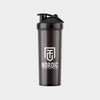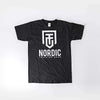What are knee sleeves?
We notice that knee sleeves, also called knee warmers, are becoming more and more popular in the training world, as they provide warmth and compression to the knees. Our knee warmers increase blood flow and stability in the knees, which helps you perform with better control.
When you perform a workout, e.g. squats, you feel the warming effect from our knee warmers directly, which stimulates blood flow and often reduces pain and discomfort in your knees.
Our knee warmers can also be used after exercise, as they can help you in the recovery process by reducing swelling and minimizing pain. They are also a great help for you who train CrossFit for this very reason.
What are the benefits of using knee sleeves?
As we mentioned earlier, one of the biggest benefits of using our knee sleeves is its ability to increase blood flow and provide pain relief. Apart from that, there are several other benefits to them.
Here are some of our favorite benefits that our knee warmers provide:
1. Knee support.
There is a lot of stress and pressure that is put on our joints during training sessions, especially on our knees. Our knee warmers are used to give you much-needed support. For this reason, they are popular with strongman, weightlifter and powerlifter. They also help with your technique by stabilizing your knees, so that you can perform better during e.g. squats and other leg exercises.
2. Knee compression.
Our knee sleeves help increase blood flow and reduce pain and swelling. This is largely due to our high quality compression material and is one of the reasons that makes them so popular. Another good reason is that our knee warmers help to warm up your knees, which in turn relieves pain.
3. Recovery for the knees.
Also in CrossFit, our knee sleeves are popular, because they help you in your recovery process. After performing WODs, you can use them to reduce swelling and pain because our knee warmers provide compression and warmth.
How do you know what size you have for knee sleeves?
There is an easy way to find the right size of our knee sleeves. They should not be loose or baggy. Tight fit on our knee warmers is usually preferable for you to get a good and correct support. However, they should not be so tight that they restrict blood flow or that they squeeze your knee / skin.
To find the right size, measure with a tape measure. If you do not have it on hand, a ruler also works together with a string.
The easiest way to measure to get the right fit:
- Start by keeping your knee extended (if you are sitting) or standing up normally.
- If using a tape measure, measure around the center of the knee joint.
- If you use a string, do the same, but measure the length of the string with a ruler afterwards.
- Once you have found the right size, compare with our size chart.
Choose a smaller size if you want extra tight-fitting knee warmers.
How to wash knee sleeves?
Taking care of your knee sleeves is an important part. After all, we sweat a lot during our workouts, and they can then become quite smelly.
There are measures you can take to prevent the smell, e.g. to turn your knee sleeves in and out after your workout and let them air dry. Below, we explain how to take care of your knee sleeves to maximize longevity.
1. Regular maintenance.
Washing knee sleeves from time to time is good so that they can regain their correct fit and support. Over time, the compression material can become a bit slack, so to restore them to their correct fit, we recommend that you wash your knee warmers regularly.
2. Normal washing.
The most common way to wash your knee sleeves is by washing them in your washing machine at 30 degrees and then letting them air dry. How often you wash your knee warmers depends on the frequency of use and odor.
3. Intensive washing.
If you need a more intense wash, you can boil your knee sleeves in warm water. Put them in a saucepan filled with water for 5 minutes. After boiling, remove the pan from the heat and add a little detergent. Let cool. When your knee warmers have cooled down, rinse them with water and allow to air dry.
4. Extreme washing.
For extreme cases and to remove mold, an alternative is to use distilled white vinegar and soak your knee sleeves in a hot water vinegar solution. Soak them for about 10 minutes, then wash them by hand or throw them in your washing machine. Let them air dry, then you're done.
How should knee supports fit?
Wearing knee supports correctly is crucial for them to provide optimal support and reduce the risk of injuries. The knee supports may need to fit differently on different people, depending on your purpose of wearing the knee supports . Here are some things to consider in terms of how knee supports should fit:
- Fit: Knee supports should fit snugly, but not so tightly that they cut into the skin or restrict blood circulation.
- Placement: The knee support should cover the knee joint and surrounding muscles and ligaments. It's important that the sleeve doesn't slide down or twist during activity, as this can reduce the effect of the support and cause discomfort.
- Purpose: Depending on what type of activity you are doing or if you are using knee supports to recover from an injury, it can affect how the knee supports should fit. For power sports such as weightlifting and strength training, a tighter fitting knee supports can provide extra stability and support. However, if you are using knee supports for rehabilitation or everyday support, you may prefer a looser fit for increased comfort.
- Individual preferences: Some people may prefer to wear knee supports over workout clothes, while others choose to wear them directly against the skin. Try different ways of wearing the knee supports to find the most comfortable and effective method for you.
How tight should a knee supports be?
Understanding how knee supports, or knee sleeves, should fit is important for achieving optimal support and comfort. When choosing how tight your knee supports should be, you should take into account both the type of training and the individual user.
Depending on the type of training you are doing, it may be more or less beneficial to have tight-fitting knee supports. For power athletes such as weightlifters, Strongman competitors, and strength trainers, a tighter fitting knee support can provide extra stability and support, while runners or cyclists may prefer a looser fit for increased comfort and mobility.
It is also important to bear in mind that knee supports do not necessarily have to fit the same tightness on all people. Each individual has unique conditions and needs, which means that the fit and how tight the knee support should be can vary. It is important to experiment and find the best fit and placement for your individual needs.
When it comes to pros and cons of how tight knee supports should be, there are some things to consider. The benefits of having tight-fitting knee supports include increased stability and support, which can be particularly valuable during power sports. The drawbacks could be that it may feel uncomfortable or restrict blood circulation if the knee sleeve is too tight. It is important to find a balance between support and comfort to ensure that the knee supports provide the best possible benefit.
By considering the type of training and individual conditions, you can adjust how tight your knee supports should be to achieve maximum effect.
 Lifting Straps
Lifting Straps Lifting Belts
Lifting Belts Nordic Grips
Nordic Grips Knee Sleeves
Knee Sleeves Elbow Sleeves
Elbow Sleeves Wrist Wraps
Wrist Wraps Knee Wraps
Knee Wraps Smelling Salt
Smelling Salt Supplements
Supplements  Neoprene Shorts
Neoprene Shorts Grip Shirt
Grip Shirt Deadlift socks
Deadlift socks Gym Chalk
Gym Chalk  Lifting Shoes
Lifting Shoes Strongman Tacky
Strongman Tacky Stone Sleeves
Stone Sleeves Sandbags
Sandbags Calf & Shin Sleeves
Calf & Shin Sleeves Compression Cuffs
Compression Cuffs Accessories
Accessories
 Best Seller
Best Seller Sale
Sale News
News Lifting Straps
Lifting Straps Lifting Belts
Lifting Belts Nordic Grips
Nordic Grips Knee Sleeves
Knee Sleeves Elbow Sleeves
Elbow Sleeves Wrist Wraps
Wrist Wraps Knee Wraps
Knee Wraps Smelling Salt
Smelling Salt Supplements
Supplements  Neoprene Shorts
Neoprene Shorts Grip Shirt
Grip Shirt Deadlift socks
Deadlift socks Gym Chalk
Gym Chalk  Lifting Shoes
Lifting Shoes Strongman Tacky
Strongman Tacky Stone Sleeves
Stone Sleeves Sandbags
Sandbags Calf & Shin Sleeves
Calf & Shin Sleeves Compression Cuffs
Compression Cuffs Accessories
Accessories



 Lifting Straps
Lifting Straps Lifting Belts
Lifting Belts Nordic Grips
Nordic Grips Knee Sleeves
Knee Sleeves Elbow Sleeves
Elbow Sleeves Wrist Wraps
Wrist Wraps Knee Wraps
Knee Wraps Smelling Salt
Smelling Salt Neoprene Shorts
Neoprene Shorts Grip Shirt
Grip Shirt Deadlift socks
Deadlift socks Lifting Shoes
Lifting Shoes Strongman Tacky
Strongman Tacky Stone Sleeves
Stone Sleeves Sandbags
Sandbags Calf & Shin Sleeves
Calf & Shin Sleeves Compression Cuffs
Compression Cuffs Accessories
Accessories








